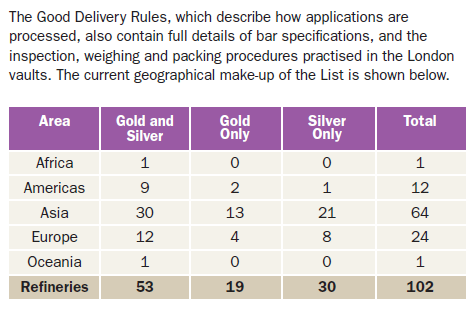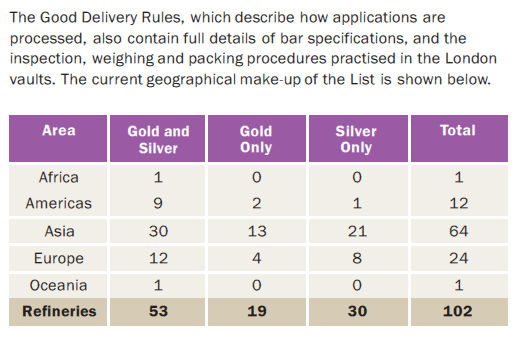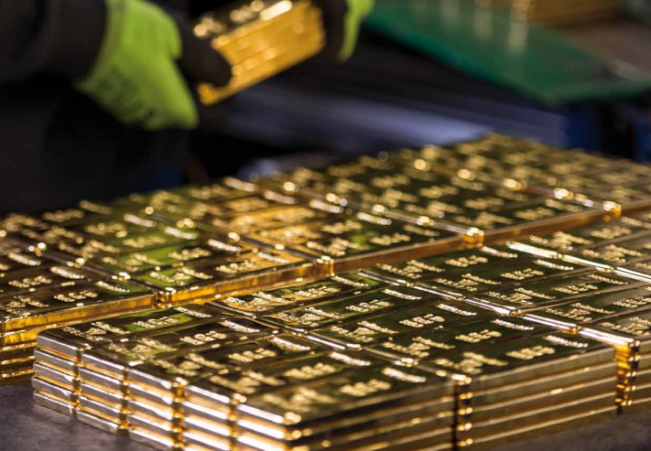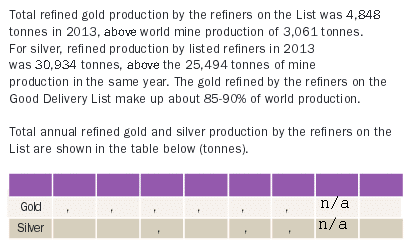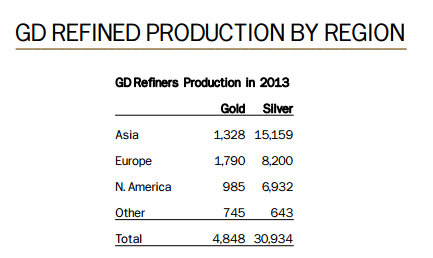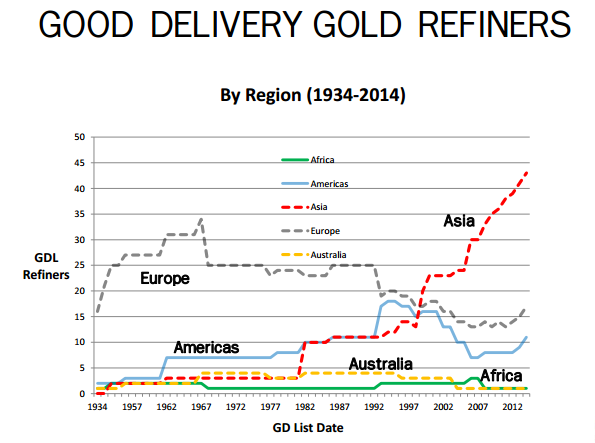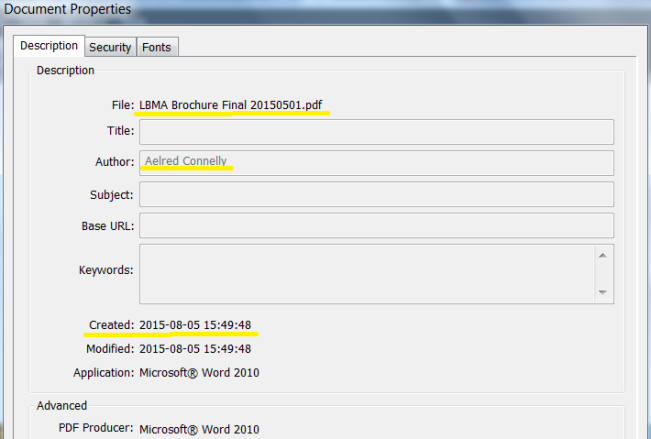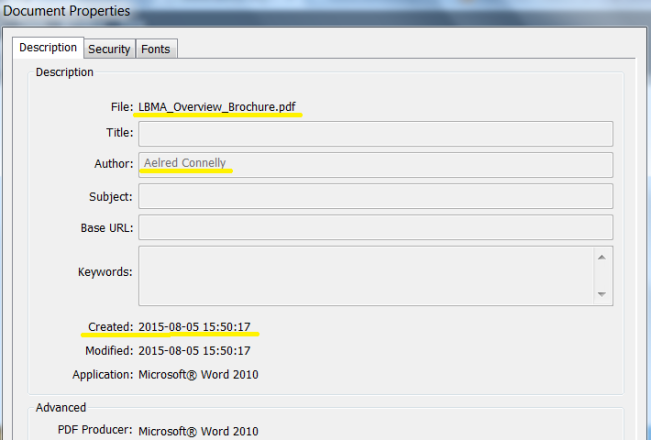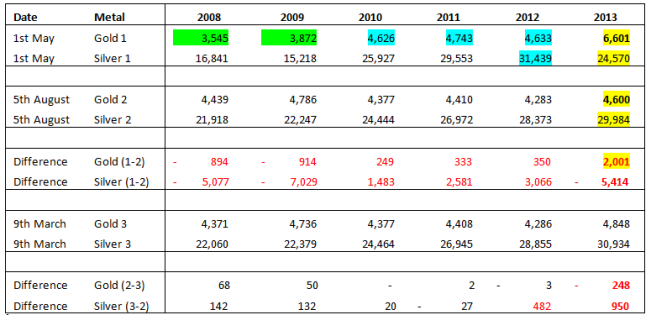The LBMA’s Shifting Stance on Gold Refining Statistics
On Friday 31st July 2015, I released an article discussing the sale of Swiss gold refiner Valcambi to Indian jewellery company Rajesh Exports. In my report, in a section about Valcambi’s annual gold refining capacity, I made passing reference to 2013 gold refining production statistics that had been published by the London Bullion Market Association (LBMA) on 1st May 2015. These same gold refinery production statistics had also been quoted by the LBMA as recently as July 2015 in the news section of Issue 78 of its ‘Alchemist’ magazine, (published on 21st July 2015, just a week before my article).
The reference in my article to 2013 LBMA gold refiner production statistics discussed the unprecedented 6,601 tonnes of gold that was refined in 2013 by gold refineries on the LBMA’s Good Delivery List. My reference to this 6,601 tonnes on 31st July, including a short table of LBMA data, was as follows:
“Rajesh Exports just revealed in its press release that over the last 3 years, Valcambi has refined an annual average of 945 tonnes of gold and 325 tonnes of silver (2835 tonnes of gold and 975 tonnes of silver over 3 years). Presumably the last 3 years that Rajesh mentions refers to the last 3 calendar years of 2012-2014.
The London Bullion Market Association (LBMA) doesn’t reveal annual production data of its refinery members on an individual level, however, the LBMA recently published high level totals of the refined gold production of its accredited refiners (LBMA Good Delivery List) over the years 2006 to 2013. What was striking about the data was that total refined gold production of its refinery members reached 6,601 tonnes in 2013, which was 42% higher than total refined gold production in 2012, and also more than double global mine production of 3,016 tonnes of gold in 2013. See table below from LBMA publication:
Total annual refined gold and silver production by LBMA refiners 2006-2013 (tonnes)
So with Valcambi being the largest gold refinery in the world, it would be realistic to suggest that its annual average of 945 tonnes of refined gold output over the last 3 years probably hides the higher refined gold production that it too experienced in 2013 versus 2012.”
In the first quoted paragraph, above the table, I had hyperlinked the word ‘publication’ to a LBMA source document URL which pointed to a pdf document named ‘LBMA Brochure Final 20150501.pdf’.
The ‘LBMA Brochure Final 20150501.pdf’ file was a 4 page document titled “A guide to The London Bullion Market Association”, with the refinery production statistics appearing on page 3 under a page title “The LBMA Good Delivery List”. The file ‘LBMA Brochure Final 20120501.pdf’ was created on 2015-05-01 at 10:09:50 using the applications Adobe InDesign CS 5.5 (7.5) and Abode PDF Library 9.9.
In the refinery section of the LBMA Brochure Final 20120501.pdf’ document, the LBMA’s commentary first explained what the Good Delivery ‘List’ refers to, as well as listing the number of gold and silver refineries on the List, and then proceeded to comment on the ‘Total refined gold production of the refiners on the List‘ in 2013, which it stated was 6,601 tonnes. The LBMA commentary also highlighted that this 6,601 tonnes of refined gold production by the refiners on the List was ‘more than double‘ 2013 world mine production of 3,061 tonnes.
The ‘List’ specified 72 refineries which refined gold, and 83 refineries which refined silver. It also showed that 16 refineries which refined gold were in Europe, 43 in Asia, 11 in the Americas, and 1 each in Africa and Oceania. So the 6,601 tonnes of gold statistic for 2013 represented 72 refineries on the Good Delivery List which refined gold. And the LBMA made clear in its commentary that refiners on the Good Delivery List represent 85%-90% of world gold production:
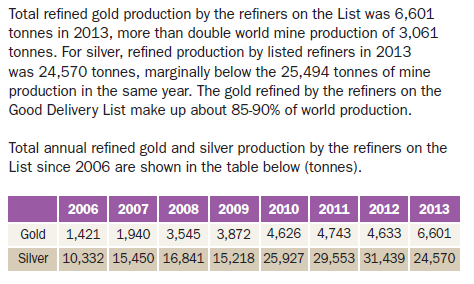
As mentioned above, the LBMA also printed the same 2013 gold refining figure of 6,601 tonnes in Issue 78 of its magazine, ‘Alchemist’, which was published on 21st July 2015. Alchemist is published in both hard copy magazine format and on-line. In the ‘LBMA News’ section of Issue 78, viewable here and here(Alch78LBMANews), the LBMA Chief Executive, Ruth Crowell, provided a news update on the Association’s Physical Committee, stating:
“Total refined gold production represented by the accredited refiners on the LBMA’s Good Delivery List was 6,601 tonnes in 2013, more than double mine production of 3,061 tonnes. For silver, refined production by listed refiners was 24,570 tonnes, marginally below the 25,494 tonnes of mine production in the same year."
[The full issue of Issue 78 of The Alchemist can be viewed here (large file)]
According to the LBMA, the ‘Physical Committee is made up of industry experts from the physical bullion market“, therefore this physical committee is well aware of the 6,601 tonnes of gold refinery production figure in 2013, not least because it’s printed in the committee’s news section in the latest edition of the Alchemist.
The explosion in gold refining activity in 2013, and the huge throughput of Good Delivery bars being transformed into smaller higher fineness bars for the Asian gold market was without doubt one of the biggest stories in the gold world during 2013. I had cited the 6,601 tonnes figure to help support a calculation about Valcambi refining capacity, and my reference wasn’t really central to the main topic of my Valcambi article. But it was a topic that I was planning to re-visit, and I tweeted about it on 4th June when I first read the LBMA report that contained the 6,601 tonnes data:
LBMA said “Total refined gold production by refiners on List was 6601 tonnes in 2013, more than double world mine production of 3061 tonnes"
— Ronan Manly (@ronanmanly) June 4, 2015
All of the above seems logical and easy to understand. It was therefore surprising to notice that on Wednesday 5th August 2015, three business days after my Valcambi articles was published, the LBMA substantially amended the gold refinery figures in the file ‘LBMA Brochure Final 20150501.pdf‘, and dramatically lowered the 2013 refined gold production figure from 6,601 tonnes to 4,600 tonnes, while substantially altering the wording and meaning of the paragraph commenting on the refined tonnage. The document content was amended and re-saved with the same file name LBMA Brochure Final 20150501.pdf‘, and left in the same web directory. So anyone viewing the LBMA document for the first time would not know that the gold refining figures in the report had been altered and substantially reduced. The file directory in question is here, and contains the altered report:
http://www.lbma.org.uk/assets/market/gdl/LBMA%20Brochure%20Final%2020150501.pdf
(The ‘%20’ instances are just space delimiters within the URL)
Luckily, the original version of ‘LBMA Brochure Final 20150501.pdf‘ from 1st May 2015 can be viewed here -> LBMA Brochure Final 20150501.
Let’s look at what was changed between the two versions. Here is the exact updated LBMA text and data table after the Wednesday 5th August changes, including the matrix displaying the number of gold and silver refineries on the ‘List’. The number of refineries remained unchanged. However, notice the 2013 gold refining figure became 4,600 tonnes:
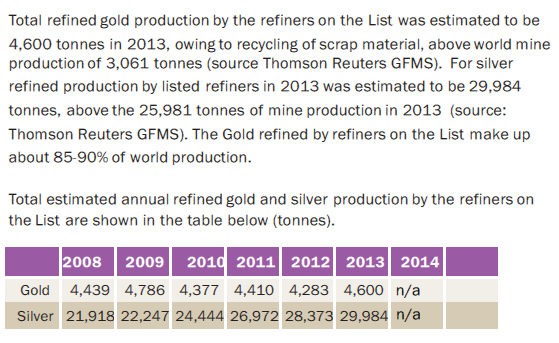
If you compare the original and altered versions of this LBMA report, you will see substantial differences. Here is a description of the changes, which I have highlighted using italics, underline and bold in various places, and the LBMA’s text is indented:
a) For gold, the LBMA reduced the 2013 total refinery production figure from 6,601 tonnes to 4,600 tonnes, a reduction of 2,000 tonnes of gold. To put the sheer magnitude of 2,000 tonnes of gold into perspective, 2,000 tonnes of gold is nearly twice as much gold as the Swiss National Bank (SNB) officially reports that it holds. [The SNB claims to have 1,040 tonnes of gold].
The LBMA added that words ‘estimated to be‘ in front of the 4,600 tonnes figure, and the words ‘owing to recycling of scrap material‘ were added after the figure. The ‘more than double‘ reference to the 6,601 tonnes of gold being more than double world mine production, was deleted and replaced by the word ‘above‘. The words ‘source Thomson Reuters GFMS‘ were added in brackets at the end of the sentence. The wording of “total refined gold production by the refiners on the List‘ was retained and not altered.
“Total refined gold production by the refiners on the List was estimated to be 4,600 tonnes in 2013, owing to recycling of scrap material, above world mine production of 3,061 tonnes (source Thomson Reuters GFMS)."
b) For silver, the 2013 total refinery production figure of 24,570 tonnes was increased to 29,984 tonnes, an increase of 5,500 tonnes. The words ‘estimated to be‘ were also added in front of the 29,984 tonnes figure. Unlike gold, no wording was added about recycling of scrap material. Since the LBMA upped the 2013 silver total so much, it was now far above mine production, so the previous words ‘marginally below‘ were replaced by the word ‘above‘. Again, the words ‘source: Thomson Reuters GFMS‘ were added in brackets at the end of the sentence.
“For silver[,] refined production by listed refiners in 2013 was estimated to be 29,984 tonnes, above the 25,981 tonnes of mine production in 2013 (source: Thomson Reuters GFMS).“
c) The altered text still retained all of the references to the Good delivery refiner ‘List’, and still stated that the figures in the table were for ‘estimated annual refined gold and silver production by the refiners on the List’.
“The Gold refined by refiners on the List make up about 85-90% of world production. Total estimated annual refined gold and silver production by the refiners on the List are shown in the table below (tonnes).”
d) The years 2006 and 2007 were removed entirely from the table in the changed version from 5th August, with the revised version only covering the years 2008 – 2013 and not 2006 – 2013 as per the original.
As the number of gold refiners in the ‘List’ above remained the same in this altered version as in the original version, there can be no doubt that this refers to the same group of gold refiners which had combined production output of 6,601 tonnes of gold in 2013 yet also, simultaneously (and impossibly) according to this altered version of the report, had a combined 4,600 tonnes of gold production output in 2013.
Total refined gold production of the refiners on the List
Question: How does the LBMA know that “Total refined gold production of the refiners on the List" was 6,601 tonnes in 2013?
Answer: Because the Good Delivery refiners provide annual refinery production figures to the LBMA. It’s as simple as that.
Every refiner on the LBMA’s Good Delivery list is required to provide production data to the LBMA on an annual basis. This information is required by the LBMA as part of its obligatory Pro-Active Monitoring (PAM) programme of Good Delivery refiners. The PAM programme is defined by the LBMA as follows:
“The PAM programme reviews the assaying competence of refiners on a three-yearly basis. In addition, it checks that they continue to meet the minimum requirements for refined production and tangible net worth on an annual basis."
This production data was supplied to the LBMA on a three-yearly basis until 2011, but the rules were changed in 2011 to an annual basis. From ‘Alchemist’ issue 65, December 2011:
“Some important changes in the Rules have been agreed recently. The first is that refiners will have to provide data on their tangible net worth and production on an annual, rather than a three-yearly, basis."
In the LBMA’s most recent Good Delivery Rules from March 2015, ‘Section 10 Pro-Active Monitoring’ states that:
“All current Good Delivery refiners are also required to submit their production and audited financial data on an annual basis to the Executive. “
Annex A of the same document, clarifies the compliance date and states:
“With effect from 1st January, 2012, all current Good Delivery refiners are required to submit their refined production and audited financial data on an annual basis to the Executive."
Additionally, refiners applying to be accepted on the LBMA’s Good Delivery list need to submit a three year operating history with three years of production figures as part of the application. Annex A (Application Form), addressing what to include with an application, states that required documents include:
- Figures for the last three years’ annual production of refined * gold/silver in tonnes.
- Estimate of next two years’ annual production of refined * gold/silver in tonnes.
The asterick (*) states that ‘refined’ refers to “metal which has gone through a refining process, such as electrolysis, Miller Process or Aqua Regia refining“. These processes would apply to Good Delivery bars that were being converted into 9999 fineness kilobars for the Asian gold market.
Therefore, the LBMA knows exactly, down to the exact tonne, the figure for “total refined gold production of the refiners on the List" in 2013.
In issue 74 of the LBMA’s ‘Alchemist’ published in June 2014, when the LBMA’s Physical Committee was providing a news update on ‘Pro-active Monitoring’, and reviewing the 2011 refinery production statistics which had just been finalised at that time, the Committee highlighted the following:
“A number of issues arising from proactive monitoring of refiners on the list have also been discussed….Two very interesting numbers arising from this work are the figures for total refined production represented by the accredited refiners. Although it takes time to complete this data collection, the figures for 2011 are now complete. The total for gold is 4,695.8 tonnes and for silver is 28,395.5 tonnes, in both cases significantly above the respective world mine production of 2,838.1 tonnes and 23,545 tonnes.“
It appeared that the writer of that paragraph thought that the two refining numbers were interesting enough to be comment worthy because the numbers were ‘significantly above‘ the world mine production figures.
The LBMA also administers a ‘Responsible Gold Audit Programme’ for gold refiners on its Good Delivery List. The audit seeks to determine whether a refiner complies with the LBMA’s ‘Responsible Gold Guidance’. The actual audits are carried out by independent auditors that have been approved by the LBMA, but the audit results are passed back to the LBMA. For example, in February 2014, the LBMA issued a press release announcing that 4 refiners had successfully passed the audit. The announcement mentioned that:
“the audit reviewed the refiners’ production over a 12 month period. The LBMA received a large volume of reports in late 2013, and will continue to report in the coming weeks as each batch is reviewed."
Therefore, the audits are another way in which the LBMA keeps track of the refiners production, in addition to the reporting coming in from the Pro-active Monitoring programme. Either way, the LBMA knows the refinery production statistics of the Good Delivery refiners and does not need to get estimates from GFMS or any other body.
Thomson Reuters GFMS
Given the above, then why the sudden need by the LBMA on 5th August 2015 to include a reference to “source Thomson Reuters GFMS“? By including the reference to “owing to recycling of scrap material", it is clear that the intention was to solely relate the 4,600 tonnes of gold quoted to just two sources, namely, gold mining and gold scrap recycling. Furthermore, why had the figure suddenly become an ‘estimate’ and who was responsible for the estimate? There is no need for estimates of refinery production when every refinery on the Good Delivery ‘Lists’ provides the exact real production figures to the LBMA.
Additionally, what was the reason for suddenly throwing a perfectly logical paragraph out the window which had referred to gold refinery production statistics for 2013 collected by the LBMA, and replace it with an estimate about gold mining and scrap recycling from a company, GFMS, which does not specialise in collecting gold refinery production statistics?
What is GFMS?
GFMS was a metals analysis consultancy firm, that was acquired by Thomson Reuters in August 2011. GFMS was formerly known as Gold Fields Mineral Services. The group within Thomson Reuters is now known as Thomson Reuters GFMS. GFMS gathers supply and demand figures for gold and other precious metals, and publishes an annual gold survey and related update reports.
GFMS’s supply data for gold mine production and gold scrap is not the same metric as gold refinery production output, and is not even close to being the same metric, especially in 2013 when there were huge amounts of Good Delivery gold bars re-smelted and re-cast into smaller gold bars in Switzerland and other places for onward shipment to Asia.
‘LBMA Overview Brochure.pdf’
The LBMA also makes reference to annual gold and silver refinery figures in another document on its website, in a file named ‘LBMA Overview Brochure.pdf‘. This document is located in a ‘presspack’ directory, presumably for use by the LBMA’s Fleet Street press contacts. This document has, in its various iterations, included a paragraph with identical phraseology about refinery production statistics i.e. ‘Total refined gold production by the refiners on the List‘, and has also included a similar table of gold and silver production statistics of LBMA accredited refineries.
On Saturday 1st August, the version of this other file, the ‘LBMA Overview Brochure.pdf‘ document on the LBMA web site, had also been altered with some very strange temporary alterations inserted for 2013 gold and silver refinery production statistics. All of the annual refinery figures in the entire table had been blanked out of the table with the shorthand ‘n/a‘ substituted in each row. The text had also been changed, and 4,848 tonnes had been inserted as the gold refineries’ production figure for 2013, and 30,934 tonnes for silver, with the word ‘above‘ added before world mine production for both metals. The overwritten figures and text appeared in a slightly scrawled text font (see below). GFMS was not mentioned in this file. The file, on 1st August, in its web directory (http://www.lbma.org.uk/assets/downloads/presspack/) rendered in a web browser as follows, when this image was recorded:
Why 4,848 tonnes?
So, where did this 4,848 tonnes figure for gold, and 30,934 tonnes for silver come from? These numbers are another entirely different set of figures for 2013, a third set if you will. To answer where these numbers came from, we need to turn to a presentation given by Stewart Murray, former LBMA CEO, at the LBMA’s Assaying and Refining Conference held in London between 8th – 10th March 2015. In a presentation titled " The LBMA Good Delivery List, Recent and Future Changes“, on 9th March, Murray utilised slides which, on page 9 showed the following:
Notice, that for 2013, the figures are 4,848 tonnes for gold, and 30,934 tonnes for silver. This dataset also only goes from 2008 to 2013.
GFMS also makes another appearance in this slide, with a GFMS combined mine production and recycled scrap figure for 2013 being quoted as 4,302 tonnes for gold, and 31,460 tonnes for silver, respectively.
The next slide in that presentation, slide 10, even gives a regional breakdown of the 4,848 tonnes and 30,934 tonnes figures, attributing 1,790 tonnes of gold refining to Europe in 2013. Keep these figures in mind as we go through this maze of numbers.
Slide 6 of the same presentation showed a line graph of the Good Delivery gold refiners that were referred to in the production figures in slide 9. You can see that the numbers of refiners in each line as at 2014 equate to the numbers of gold refiners in the ‘List’ of the original ‘LBMA Brochure Final 20150501.pdf‘ file, i.e. 16 gold refiners in Europe, 43 in Asia, 11 in the Americas, 1 in Australia (which was Oceania in the List – the Perth Mint), and 1 in Africa (Rand Refinery). So again, there can be no doubt that they are the same refiners being referred to here that had a production output of 6,601 tonnes of gold in 2013, and at the same time 4,848 tonnes. So the same refiners have been at work in 3 parallel universes during 2013, or so it may seem.
By Wednesday 5th August, the ‘LBMA Overview Brochure.pdf‘ file had also been updated and re-saved, and contained the exact same commentary text and the exact same table of refinery production output figures as the altered ‘LBMA Brochure Final 20150501.pdf‘, i.e. the 4,848 tonnes figure was gone and was replaced by 4,600 tonnes, and the file was re-saved by the LBMA with the same file name, and left in the same file directory that it had been in, i.e.
Again, a first time viewer would not know by looking at the report that the gold and silver refinery production figures had been altered and the text edited.
What do the document properties of the re-saved ‘LBMA Brochure Final 20150501.pdf‘ and ‘LBMA Overview Brochure.pdf files, saved on Wednesday 5th August tell us?
‘LBMA Brochure Final 20150501.pdf‘ was saved at 15:49:48 on 5th August by author name Aelred Connelly. Then 29 seconds later at 15:50:17 on 5th august, file ‘LBMA Brochure Final 20150501.pdf‘ was also saved by author name Aelred Connelly. Aelred Connelly is the LBMA’s Public Relations Officer, ex Bank of England for more than 25 years, where he was a gold bullion analyst and a relationship manager for the Bank’s central bank and government customers.
So, what is going on here?
Could it be that the LBMA’s original figure of 6,601 tonnes of refinery gold production in 2013 should not have been published for some reason, and needed to be quickly changed, for example, that the publication of this metric breached refiner confidentiality, or that it just made the GFMS supply numbers look way out of line with reality?
Previous LBMA documents discussing refined gold production
There are a number of other slightly older LBMA reports, brochures and other documents which discussed and recorded Good Delivery refinery annual production statistics. The interesting aspect of these other files, apart from the numbers, is that the syntax and wording is identical to the version from 1st May 2015 which I had quoted and which disappeared by 5th August. Furthermore, none of the older versions match (in style) the new versions that use ‘estimates’ and that refer to Thomson Reuters GFMS.
The previous syntax also seemed totally adequate for use by regulatory agencies such as the US SEC, and the UK Treasury’s Fair and Efficient Markets Review.
A file here refers to 2009 refinery figures. The same statistics were quoted in version created on 19th April 2012, for use in a LBMA meeting with the US Securities Exchange Commission (SEC) on 18th April 2012:
“Total refined gold production by the refiners on the List was more than 4,000 tonnes in 2009, well above world mine production of 2,611 tonnes. For silver, refined production by listed refiners of 22,800 tonnes was marginally greater than the 22,342 tonnes of mine production in the same year.”
Then there is another version that was saved as 23rd May 2014 but refers to 2011. It was also used in January 2015, in a letter from the LBMA to the Fair & Effective Markets Review, Bank of England:
“Total refined gold production by the refiners on the List was 4,695.8 tonnes in 2011, well above world mine production of 2,838.1. For silver, refined production by listed refiners of 28,395.5 tonnes was greater than the 23,545 tonnes of mine production in the same year.”
Another newer version on 12th August 2015
There is also an even newer version of a file specifying “total refined gold production by the refiners on the List" now uploaded on the LBMA web site. This latest document, called “A guide to The London Bullion Market Association August 2015“, is from 12th August 2015.
“Total refined gold production by the refiners on the List was estimated to be 4,579 tonnes in 2013, owing to recycling of scrap material, above world mine production of 3,061 tonnes (source: Thomson Reuters GFMS). For silver, refined production by listed refiners in 2013 was estimated to be 28,013 tonnes, above the 25,981 tonnes of mine production in 2013 (source: Thomson Reuters GFMS). The Gold refined by refiners on the List make up about 85-90% of world production. Total estimated annual refined gold and silver production by the refiners on the List are shown in the table below (tonnes).”
In this version, a refinery in China (Daye Nonferrous Metals Company) was accredited to the Good Delivery List for gold in June 2015, and so it was moved from the silver only category to the gold and silver category on the List. Why the 2013 gold production figure was then reduced again from 4600 tonnes to 4579 tonnes is unclear, and even more mysterious is why the 2013 silver production figure became 28,103 tonnes,when in the two report versions from 5th August LBMA , the 2013 silver production total had been 29,984 tonnes. That’s a reduction of 1,871 tonnes of silver between 2 LBMA reports that were published a week apart.
Table: Comparisons – LBMA refinery production (1st May vs 5th August vs 9th March)
It is not just 2013 where the refinery production statistics deviate significantly for both gold and silver. For gold, the altered figures were applied to 2012, 2011 and 2010 also. For 2009 and 2008, the revised data is actually higher for gold than the 1st May 2015 published version. The differences in 2010, 2011, and 2012, and indeed, 2008 and 2009 require explanations also.
For silver, the altered figure for 2013 is, as mentioned earlier, more than 5000 tonnes higher in the newer version. This article has focused on gold. I have not looked at the silver angle. Other people may wish to explore the silver angle.
The figures in the newer LBMA documents of 5th August are very close to the figures used by Stewart Murray in his 9th March presentation, except for 2013 in gold and silver, and in silver in 2012. There is still however, a 248 tonne difference between the 4,848 tonnes 2013 gold production figure quoted by Murray on 9th March, and the lower 2013 gold figure of 4,600 tonnes added into the LBMA documents on 5th March.
Conclusion
There are 2,300 tonnes of 2013 gold refining output in excess of combined mine production and scrap recycling being signalled within the 6,601 tonnes figure that was removed from the LBMA’s reports on 5th August 2015.
Could it be that this 6,601 tonne figure included refinery throughput for the huge number of London Good Delivery gold bars extracted from gold ETFs and LBMA and Bank of England vaults and converted into smaller gold bars in 2013, mainly using LBMA Good Delivery Swiss gold refineries? And that maybe this 6,601 tonne figure stood out as a statistical outlier for 2013 which no one wanted to talk about?
The objectives of HM Treasury’s Fair and Efficient Markets Review (FEMR) include transparency and openness. It would appear that altering already published gold refinery statistics, especially for 2013, seems not to be in the spirit of these FEMR objectives.
Part 2 of this analysis of the LBMA’s 2013 gold refinery statistics looks behind the 6,601 tonne number at the phenomenon of Good Delivery bars being processed through the Swiss gold refineries in 2013, the gold withdrawals from the London-based gold ETFs, and the huge shipments of gold from the UK to Switzerland in 2013. Part 2 also examines the 2013 withdrawal of gold from the Bank of England, and how GFMS and the World Gold Council tried to, or tried not to, explain the non-stop processing of Good Delivery gold bars into smaller finer kilobars during 2013.
Popular Blog Posts by Ronan Manly
 How Many Silver Bars Are in the LBMA's London Vaults?
How Many Silver Bars Are in the LBMA's London Vaults?
 ECB Gold Stored in 5 Locations, Won't Disclose Gold Bar List
ECB Gold Stored in 5 Locations, Won't Disclose Gold Bar List
 German Government Escalates War On Gold
German Government Escalates War On Gold
 Polish Central Bank Airlifts 8,000 Gold Bars From London
Polish Central Bank Airlifts 8,000 Gold Bars From London
 Quantum Leap as ABN AMRO Questions Gold Price Discovery
Quantum Leap as ABN AMRO Questions Gold Price Discovery
 How Militaries Use Gold Coins as Emergency Money
How Militaries Use Gold Coins as Emergency Money
 JP Morgan's Nowak Charged With Rigging Precious Metals
JP Morgan's Nowak Charged With Rigging Precious Metals
 Hungary Announces 10-Fold Jump in Gold Reserves
Hungary Announces 10-Fold Jump in Gold Reserves
 Planned in Advance by Central Banks: a 2020 System Reset
Planned in Advance by Central Banks: a 2020 System Reset
 China’s Golden Gateway: How the SGE’s Hong Kong Vault will shake up global gold markets
China’s Golden Gateway: How the SGE’s Hong Kong Vault will shake up global gold markets






 Ronan Manly
Ronan Manly 0 Comments
0 Comments
